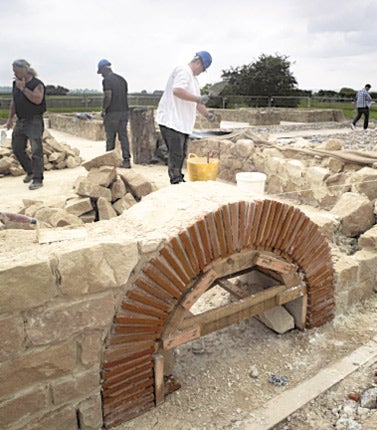Channel 4 programme confirms the cliché is true - Rome wasn't built in a day
A group of modern craftsmen put up a villa using only the tools and materials the Romans would have used.

Thankfully not every building project begins with an inspection of entrails cut from the local livestock. But then again the new English Heritage attraction in Shropshire, which opens next month, is no ordinary building.
In an ambitious experiment, a team of six modern-day builders have constructed an authentic replica Roman villa using only the skills, tools and materials available to the Romans. And the lamb's liver they consulted at the start of the project was a common surveying tool 2000 years ago. A discoloured liver indicates liver fluke, which lives in flood-prone low-lying land that is unsuitable to build on.
Luckily for the project, the liver was healthy and construction began last summer at the Roman village in Wroxeter. The project was documented by Channel 4 and the subsequent six-part series, Rome Wasn't Built in a Day, begins on 18 January.
The project was overseen by Professor Dai Morgan Evans, an archaeologist from the University of Chester. He designed the villa by piecing together evidence from existing ruins to build a picture of how invading Romans in the west of Britain would have constructed their homes. For guidance the builders could consult a 2,300-year-old DIY manual, De Architectura, written by Caesar's military engineer, Vitruvius; a man described as the first architect.
Professor Morgan Evans explains: "It is a very ambitious project and authenticity was extremely important. We had bits and pieces of information. Vitruvius' manual helped, but our villa was built to 300AD specifications and the manual was written 300 years before for the Italian environment, so we had an outdated book written for a different part of the world which was mainly for the military. We tried to make the villa specific for Wroxeter and western Roman Britain using local materials."
Wroxeter was once the site of Viroconium, a major Roman city and the fourth-largest settlement in Roman Britain, which was controlled by the Roman Empire between 43AD and about 410. Large villas like the one built would have dotted the countryside at the time.
The building, which will be a visitor centre when it opens, has a 30ft-high, half-timbered frame with eight stone columns at the front and a bathhouse with bath and plunge pool. It also has underfloor heating, mosaics and frescos. With no modern machinery available such as cement mixers and power tools, the builders relied on hard labour to complete the project. They hand-hued more than 150 tonnes of sandstone and cut each stone by hand. They created their own cement substitute, lime mortar, introduced to Britain by the Romans at a time when the indigenous population still used mud and clay. The project workforce mixed 30 tonnes of it to hold the stonework together.
Although versions of many modern-day tools such as trowels and planes were used by Romans the builders used ancient tools for many tasks. To mark out corners and levels, a job done by lasers today, they used a device called a groma, which consists of four hanging weights on a pole. They also attempted to build their own cart from hand-cut wood and they had to hoist the heavy roof beams and timber frame manually.
Prof Morgan Evans concludes: "It would have taken the Romans at least two years to complete what we did and that would have been with two to three times the workforce. It was like Frankenstein's monster, it was created by a mad professor and took over our lives but it should now last for a very long time."
Join our commenting forum
Join thought-provoking conversations, follow other Independent readers and see their replies
Comments
Bookmark popover
Removed from bookmarks